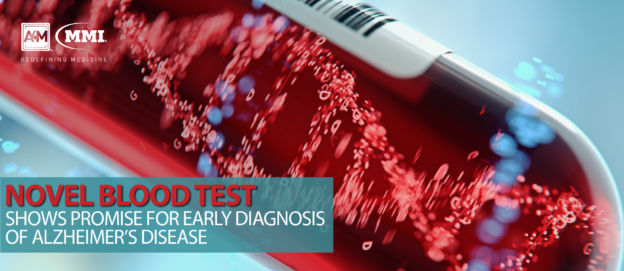Alzheimer’s disease (AD) is a debilitating and incurable condition affecting approximately 6 million Americans aged 65 and older. As the number of AD cases in the United States is projected to reach an estimated 14 million by the year 2050, there is a pressing need for effective prevention therapies. Currently, there are limitations in diagnostic testing methods for Alzheimer’s disease; to date, the diagnosis of AD has been largely based on amyloid plaques and tau tangles identified in the brain postmortem.
Emerging evidence from Lund University evaluated the potential profound impact on Alzheimer’s research and care an inexpensive and accessible diagnostic test for the presence of plaques and tangles would have. In the recent study, researchers demonstrate the great promise of a novel blood test in discriminating between persons with and without AD as well as identifying the disease in individuals at known genetic risk as early as 20 years before onset.
The large international study was recently published in the Journal of the American Medical Association (JAMA) and reveals that measurements of phospho-tau217 (p-tau217) could help medical professionals accurately identify symptoms of Alzheimer’s in living patients.
Identifying Alzheimer’s Disease
Researchers in Arizona, Sweden, and Colombia investigated the discriminative accuracy of plasma phospho-tau217 at differentiating Alzheimer’s disease from other neurodegenerative disorders. To do so, the study’s authors evaluated a new p-tau217 blood test administered in 1,402 cognitively impaired and unimpaired participants. Subjects included 81 participants from Arizona’s Banner Sun Health Research Institute Brain Donation program, 699 patients from the Swedish BioFINDER Study, and 522 Colombian autosomal dominant AD-causing mutation carriers and non-carriers.
P-tau217 Accurately Distinguishes Risk
The cross-sectional study found that plasma p-tau217 discriminated Alzheimer’s disease from other neurodegenerative diseases with significantly more accuracy than established AD plasma- and MRI-based biomarkers.
In the Arizona cohort, the novel blood test successfully discriminated between brain donors with and without the subsequent diagnosis of “intermediate or high likelihood of Alzheimer’s” with 89% accuracy. Meanwhile, in participants with and without a diagnosis of “high likelihood” the assay was 98% accurate. Higher p-tau217 measures were associated with increased brain tangle counts only in participants with present amyloid plaques.
Within the Swedish cohort, the assay discriminated between persons with clinically diagnosed Alzheimer’s and other neurodegenerative diseases with 96% accuracy, similar to tau PET scans and CSF biomarkers and better than several other blood tests and MRI measurements. Further, it distinguished between patients with and without an abnormal tau PET scan with up to 93% accuracy.
Finally, in the Colombian cohort, the blood test was able to distinguish between mutation carriers and non-carriers 20 years before their estimated age of onset of mild cognitive impairment. For all of the analyses performed, p-tau217 was found to outperform p-tau181 – a similar component of tau tangles and blood test – as well as several other studied assays; its performance did not differ significantly from that of key CSF- or PET-based measures.
In recent years, much progress has been made in the development of blood tests for Alzheimer’s disease. Although the plasma p-tau217 was found to discriminate AD from other neurodegenerative disease, additional research is needed to validate these findings in larger and more diverse cohorts in order to both optimize the blood test and determine its potential role in the clinical setting.
”The p-tau217 blood test has great promise in the diagnosis, early detection, and study of Alzheimer’s,” lead author Oskar Hansson, MD, PhD, told Science Daily.“While more work is needed to optimize the assay and test it in other people before it becomes available in the clinic, the blood test might become especially useful to improve the recognition, diagnosis, and care of people in the primary care setting.”



